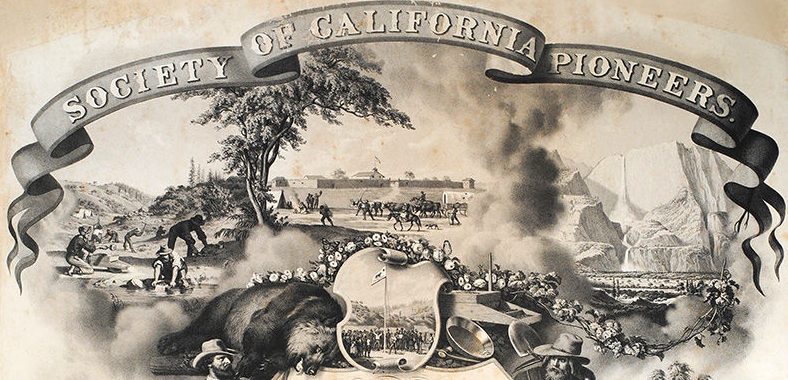Book Collecting Guide
What are Broadsides?

Ephemeron broadsides were printed without the intention of novelty: an ad for a product, or an announcement for an event, something intended to convey information. They could also be intended for entertainment, as gruesomely demonstrated by the “Last Dying Speeches” sold at public executions in eighteenth- and nineteenth-century Britain. You can learn more about these at the site for Harvard Law School Special Collections. [2] These are great examples of street literature intended for recreational consumption by the general public, most of which were printed as broadsides throughout the sixteenth- to nineteenth-centuries.
Broadsides were also key in the preservation of many traditional folk songs and ballads, and there are many early broadsides comprising the lyrics of ballads, usually paired with small illustrations. Sometimes referred to as “broadsheets,” most of these broadside ballads were printed without musical notation, but a note that the lyrics be sung to a commonly-known tune. As renowned early 20th-century folksong-scholar Lucy Broadwood says, “Before the days of cheap literature, the broadside, indeed, took the place of the newspaper, political pamphlet, history, novel, poetry-book, and hymnal of our times; and upon the ballad-sheets - largely circulated by pedlars [sic], themselves often singers— the country folk relied for fresh information, amusement, and moral instruction, the more easily assimilated when in homely verse…” [3]
Broadsides as they were— essential, purposeful publications— died out with the invention of newspapers, and “cheap literature,” or penny-dreadfuls. Early broadsides are considered ephemera, and highly indicative of the popular cultural habits of the time and place of their origin.
Poetry Broadsides
Despite their demise as a vital form of information dissemination, the broadside has certainly not gone extinct. Poetry broadsides are one of the more thriving remaining specimens, their long history tied to the first printed broadsides, and progressing through to a vibrant resurgence of broadside printing that emerged in America in the 1960’s and 70’s—mostly by smaller, independent printers seeking to artfully commemorate a momentous event, or to preserve a credo.
Many of the more collectible poetry broadsides will have been made by hand, often with a small silkscreen press or a mimeograph. As James Sullivan writes in his book On the Walls and in the Streets: American Poetry Broadsides from the 1960s:
[broadside printing] took poetry out from between closed covers resting on shelves, out of the armchair under the reading lamp, out from those quiet moments of private contemplation that have become the canonical setting for poetry, and into public places. Handed out at meetings, rallies, and street corners, posted on walls and bulletin boards, even framed to be hung in a living room or gallery or carried around all day folded in a wallet, a poem became a material sign to be touched and seen, engaging the senses rather than, as is conventional, passing transparently through them on the literary intellect. [4]
The poetry broadside is an exciting, relatively burgeoning visual reimagining of the poem. It marries the visual and literary art in a succinct, lovely way, and if you choose to start collecting poetry broadsides, the world is your oyster— there are many beauties to discover.
How to Collect Poetry Broadsides
The first step to collecting anything: figure out what you enjoy. A good place to start with poetry broadsides is to search for a specific poet that you enjoy. It is much easier to start with Walt Whitman and continue your search there. After that, consider the quality of the broadside, the year of publication, and the publisher. Smaller press publications can be more interesting and unique, but larger publishing houses will also print special limited-edition runs of a particular broadside, often coinciding with the publication of a book of poetry, or a re-release of a work by a popular poet. If you are looking for rare broadsides, there often is a handwritten or printed number denoting how many of that particular broadside were made during that particular run. If there is no number, then it is worth examining the physical object— does it look handmade? How is the quality of the paper and the ink? Does it seem like it was truly printed separately, or ripped out of a larger work? These are warning signs that they may be worth a bit less, but again, the most important thing is that the piece gives you that spark.
Take A Look!
If you want to take a look at more broadsides, poetry and otherwise, I highly recommend visiting the New York Public Library Digital Collections and doing some digging around: http://digitalcollections.nypl.org
Oxford also has an immense database of English broadside ballads: http://ballads.bodleian.ox.ac.uk/browse
Lewis & Clark University also has a poetry broadside digital collection, to give you some context: http://digitalcollections.lclark.edu/items/browse?collection=5
Utah State has an online archive of broadsides featuring specifically Beat poetry: http://digital.lib.usu.edu/cdm/landingpage/collection/Beat
[1]International League of Antiqurian Booksellers. https://www.ilab.org/eng/glossary/90-broadside.html
[2] Harvard Law School Library Special Collections. http://broadsides.law.harvard.edu
[3] Gregory, E. David. “The Late Victorian Folksong Revival: The Persistence of English Melody, 1878X1903.” Papers and Responses from the Ninth Annual Conference of the North American Victorian Studies Association 54.3 (2012): 543-545.
[4] Sullivan, James. On the Walls and in the Streets. Champain: University of Illinois Press, 1997.
